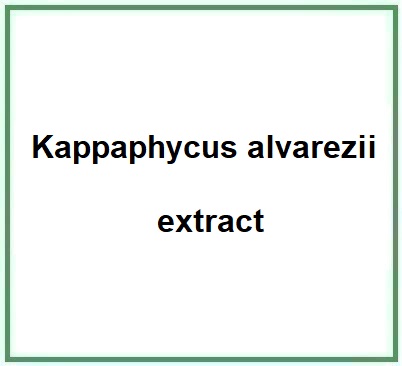Kappaphycus alvarezii extract is an extract obtained from the algae of the same name that grows in the subtidal zone (below the low tide line) of East Asia, the Pacific Ocean, Malaysia, the Philippines, Indonesia and the Caribbean. Another alga, Gigartina stellata, has been added to this extract.
The name describes the structure of the molecule
- Gigartina stellata/Kappaphycus alvarezii - These are the scientific names of the two species of red marine algae.
Description of raw materials used in production
- Gigartina stellata alga - A species of red marine alga.
- Kappaphycus alvarezii alga - Another species of red marine alga, also known as "cotton seaweed" due to its texture. Rich in carrageenan, a polysaccharide used for its gelling and thickening properties in various food and cosmetic products. It also contains natural antioxidants and moisturizing components beneficial for the skin.
Synthesis process
- Harvesting of the algae - The algae are collected from the sea or grown in aquaculture facilities.
- Extraction - The algae undergo an extraction process (often using water or organic solvents) to obtain the active ingredients.
- Purification - The extract is then purified to remove any impurities.
- Concentration and drying - The purified extract can be concentrated and dried to produce a powder product or kept in liquid form.
Form and Color
Kappaphycus Alvarezii extract typically appears as a viscous liquid or as a fine powder, with a color that can range from white to light brown.

What it is used for and where
Medical
Several studies have dealt with Kappaphycus algae as a functional food proving that this algae can reverse the metabolic syndrome through selective inhibition of obesogenic gut bacteria and promotion of gut bacteria that improve the healthy state of the human body, may be able to slow down the growth rate of cancer cells (1).
Other notable applications of this algae include its use to reduce cholesterol and for its antiviral properties (2).
Cosmetics
Skin protectant. It creates a protective barrier on the skin to defend it from harmful substances, irritants, allergens, pathogens that can cause various inflammatory conditions. These products can also improve the natural skin barrier and in most cases more than one is needed to achieve an effective result.
Skin conditioning agent. It is the mainstay of topical skin treatment as it has the function of restoring, increasing or improving skin tolerance to external factors, including melanocyte tolerance. The most important function of the conditioning agent is to prevent skin dehydration, but the subject is rather complex and involves emollients and humectants that can be added in the formulation.
Applications
- Gelling and Thickening Agents - Used in cosmetic, pharmaceutical, and food products as gelling and thickening agents.
- Hydration - The extracts may offer moisturizing properties, making them suitable for skincare products.
- Antioxidants - These extracts can have antioxidant properties, protecting the skin from free radicals.
- Protective - They can form a film on the skin, offering a protective barrier against external agents.
- Food Industry - Kappaphycus alvarezii is a primary source of carrageenan, a food additive used as a stabilizer and thickener.
Safety
Ingredient considered safe.
References_____________________________________________________________________
(1) Zhang Q, Zhou S, Lim PE, Wei B, Xue C, Xue Y, Tang Q. Kappaphycus Alvarezii Compound Powder Prevents Chemotherapy-Induced Intestinal Mucositis in BALB/c Mice. Nutr Cancer. 2022;74(10):3735-3746. doi: 10.1080/01635581.2022.2089699. Epub 2022 Jun 26. PMID: 35758096.
Abstract. This study aimed to formulate Kappaphycus alvarezii compound powder containing Kappaphycus alvarezii powder (KP), cooked sorghum powder (SP), and longan powder (LP); which was evaluated for its therapeutic effects against chemotherapy-induced intestinal mucosal injury (CIMI). Based on rheological properties, sensory evaluation, and antioxidant activity and using single factor and response surface methodology, the optimal formula to develop the compound powder was determined to be 35% KP, 30% SP, 5% LP, and 30% xylitol. Thereafter, the efficacy of the compound powder was tested by feeding BALB/c mice with diets supplemented with the Kappaphycus alvarezii compound powder (3% and 5%) for 14 consecutive days. The chemotherapeutic drug 5-fluorouracil was intraperitoneally injected (50 mg/kg) in the mice to induce CIMI for the last three consecutive days. Compared to the CIMI mice, those fed 5% Kappaphycus alvarezii compound powder (HC) showed significantly improved the intestinal injury, increased mucin-2 secretion, and reduced TNF-α, IL-1β, IL-6, LT, and COX-2 levels. Furthermore, HC intake significantly reduced the Firmicutes-to-Bacteroidetes ratio, promoted the growth of beneficial bacteria, such as Alloprevotella, and inhibited the growth of harmful bacteria, such as Clostridium. In conclusion, HC has a protective effect against CIMI and provides a novel dietary strategy for patients undergoing chemotherapy.
(2) Chin YX, Mi Y, Cao WX, Lim PE, Xue CH, Tang QJ. A Pilot Study on Anti-Obesity Mechanisms of KappaphycusAlvarezii: The Role of Native κ-Carrageenan and the Leftover Sans-Carrageenan Fraction. Nutrients. 2019 May 21;11(5):1133. doi: 10.3390/nu11051133. PMID: 31117266; PMCID: PMC6566674.
Abstract. Kappaphycus is a commercially important edible red alga widely cultivated for carrageenan production. Here, we aimed to investigate the anti-obesity mechanism of Kappaphycus alvarezii by comparing the effects of whole seaweed (T), extracted native κ-carrageenan (CGN), and the leftover fraction sans-carrageenan (SCGN) supplementations (5%, w/w) on diet-induced obese C57BL/6J mice. A high-fat diet induced both a raised body fat percentage and serum cholesterol level, increased adipocytes size, abnormal levels of adipocytokines, and promoted gut dysbiosis. Our results showed that, overall, both CGN and SCGN were more effective in reversing obesity and related metabolic syndromes to normal levels than T. Furthermore, these findings suggested that CGN- and SCGN-modulated gut dysbiosis induced by a high-fat diet, which may play an influencing role in adiponectin dysregulation. Our data also showed some evidence that CGN and SCGN have distinct effects on selected genes involved in lipid metabolism. In conclusion, both κ-carrageenan and SCGN have novel anti-obesity potential with possible different mechanisms of action.
![]() Kappaphycus alvarezii extract
Kappaphycus alvarezii extract 


